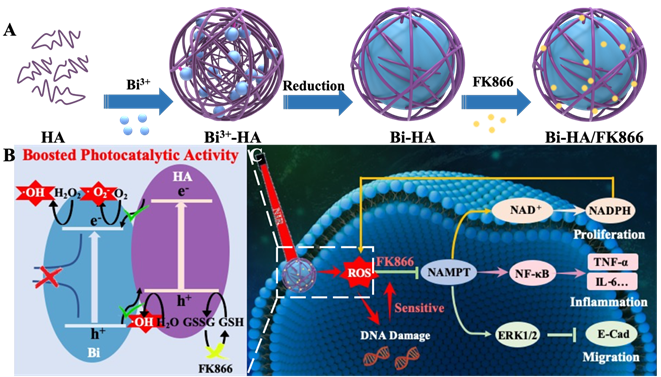Associate Professor Li Nan’s group from the School of Pharmaceutical Science and Technology reported a boosted photocatalytic activity induced NAMPT-regulating therapy to simultaneously inhibit tumor proliferation, migration, and inflammation, offering a new point of view for cancer therapy with low side effects and high therapeutic efficacy. The research result was published on Biomaterials with the title of Boosted photocatalytic activity induced NAMPT-regulating therapy based on elemental for inhibiting tumor proliferation/migration/inflammation (The link is https://doi.org/10.1016/j.biomaterials.2020.120140).
Due to the highly complex biological formation procedure, tumor is still difficult to be treated efficiently and always associated with proliferation, migration and inflammation during treatment. Herein, a novel strategy of boosted photocatalytic activity induced Nicotinamide phosphoribosyltransferase(NAMPT)-regulating therapy is used for tumors inhibition based on FK866 loaded bismuth-humic acids heterojunction (Bi-HA/FK866). With the reduction function of HA, Bi (Ⅲ) can be reduced to elemental Bi, which can be excited by NIR laser to form electron-hole pair due to the narrow bandgap. Moreover, the coated HA and Bi could form a heterojunction structure, which could decrease the electron–hole recombination, and further boost the photocatalytic activity, leading to highly efficient ROS generation and GSH depletion. The resulted ROS could induce DNA damage of the tumor cells, thus enhancing the sensitivity to the inhibitor of NAMPT (FK866) to downregulate NAD/ERK/NF-κB signal pathways, and eventually simultaneously prevent cancer progression. Moreover, the decreased NAD could downregulate NADPH and further suppress the innate antioxidant defense system by inhibiting reduction of GSSG.

Illustration of (A) prepare procedure of Bi-HA/FK866, and (B, C) mechanism of boosted photocatalytic activity induced NAMPT-regulating therapy for inhibiting tumor proliferation / migration /inflammation.
The boosted photocatalytic activity induced NAMPT-regulating therapy offers a promising way to address the important issue of penetration depth limitation induced cancer relapse and migration, providing more possibilities toward successful clinical application. Doctoral Candidate Song Yilin is the first author, and Associate Prof.Li Nan is the only corresponding author.
Biomaterials is an international journal covering the science and clinical application of biomaterials with an impact factor of 10.31 as was released by ISI (Institute for Scientific Information) in June 2019.
By the School of Pharmaceutical Science and Technology
Editor: Eva Yin






